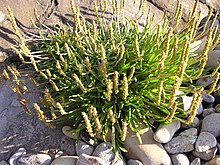Plantago maritima
| Plantago maritima | |
|---|---|

| |
| Scientific classification | |
| Kingdom: | Plantae |
| Clade: | Tracheophytes |
| Clade: | Angiosperms |
| Clade: | Eudicots |
| Clade: | Asterids |
| Order: | Lamiales |
| Family: | Plantaginaceae |
| Genus: | Plantago |
| Species: | P. maritima |
| Binomial name | |
| Plantago maritima | |
| Synonyms[2] | |
| |
Plantago maritima, the sea plantain, seaside plantain or goose tongue, is a species of flowering plant in the plantain family Plantaginaceae. It has a subcosmopolitan distribution in temperate and Arctic regions, native to most of Europe, northwest Africa, northern and central Asia, northern North America, and southern South America.[3][4]
Description
It is a herbaceous perennial plant with a dense rosette of leaves without petioles. Each leaf is linear, 2–22 cm long and under 1 cm broad, thick and fleshy-textured, with an acute apex and a smooth or distantly toothed margin; there are three to five veins. The flowers are small, greenish-brown with brown stamens, produced in a dense spike 0.5–10 cm long on top of a stem 3–20 cm tall.[5][6][7]
Subspecies
There are four subspecies:[4][7]
- Plantago maritima subsp. maritima. Europe, Asia, northwest Africa.
- Plantago maritima subsp. borealis (Lange) A. Blytt and O. Dahl. Arctic regions. All parts of the plant small, compared to temperate plants.
- Plantago maritima subsp. juncoides (Lam.) Hultén. South America, North America (this name to North American plants has been questioned[7]).
- Plantago maritima subsp. serpentina (All.) Arcang. Central Europe, on serpentine soils in mountains.
Ecology and physiology
In much of the range it is strictly coastal, growing on sandy soils. In some areas, it also occurs in alpine habitats, along mountain streams.[5] Some of the physiology and metabolism of this species has been described, of particular note is how the metabolism of this species is altered with elevated atmospheric carbon dioxide concentrations.[8][9]
Uses
Like samphires, the leaves of the plant are harvested to be eaten raw or cooked.[10][11] The seeds are also eaten raw or cooked, and can be ground into flour.[10]
References
- ^ Maiz-Tome, L. (2016). "Plantago maritima". IUCN Red List of Threatened Species. 2016: e.T64320667A67730407. doi:10.2305/IUCN.UK.2016-1.RLTS.T64320667A67730407.en. Retrieved 3 July 2024.
- ^ a b "Plantago maritima". Plants of the World Online. Royal Botanic Gardens, Kew. Retrieved 3 July 2024.
- ^ "Plantago maritima". Germplasm Resources Information Network. Agricultural Research Service, United States Department of Agriculture. Retrieved 24 December 2017.
- ^ a b Flora Europaea: Plantago maritima
- ^ a b Blamey, M. & Grey-Wilson, C. (1989). Flora of Britain and Northern Europe. ISBN 0-340-40170-2
- ^ Plants of British Columbia: Plantago maritima
- ^ a b c Flora of the Canadian Arctic Archipelago: Plantago maritima
- ^ Davey, M. P.; Harmens, H.; Ashenden, T. W.; Edwards, R.; Baxter, R. (2007). "Species-specific effects of elevated CO2 on resource allocation in Plantago maritima and Armeria maritima". Biochemical Systematics and Ecology. 35 (3): 121. doi:10.1016/j.bse.2006.09.004.
- ^ Davey, M.; Bryant, D. N.; Cummins, I.; Ashenden, T. W.; Gates, P.; Baxter, R.; Edwards, R. (2004). "Effects of elevated CO2 on the vasculature and phenolic secondary metabolism of Plantago maritima". Phytochemistry. 65 (15): 2197–2204. Bibcode:2004PChem..65.2197D. doi:10.1016/j.phytochem.2004.06.016. PMID 15587703.
- ^ a b Plants for a Future, retrieved 9 November 2016
- ^ Seymour, Tom, Foraging New England: Edible wild food and medicinal plants from Maine to the Adirondacks to Long Island Sound, 2nd ed. (Guilford, Connecticut: Morris Book Publishing, 2013), pp. 2-4. See also: Seymour, Tom (June 2009), "Free Lunch: Foraging the Maine Seashore," Fishermen's Voice (Gouldsboro, Maine, U.S.A.).
External links
 Media related to Plantago maritima at Wikimedia Commons
Media related to Plantago maritima at Wikimedia Commons

